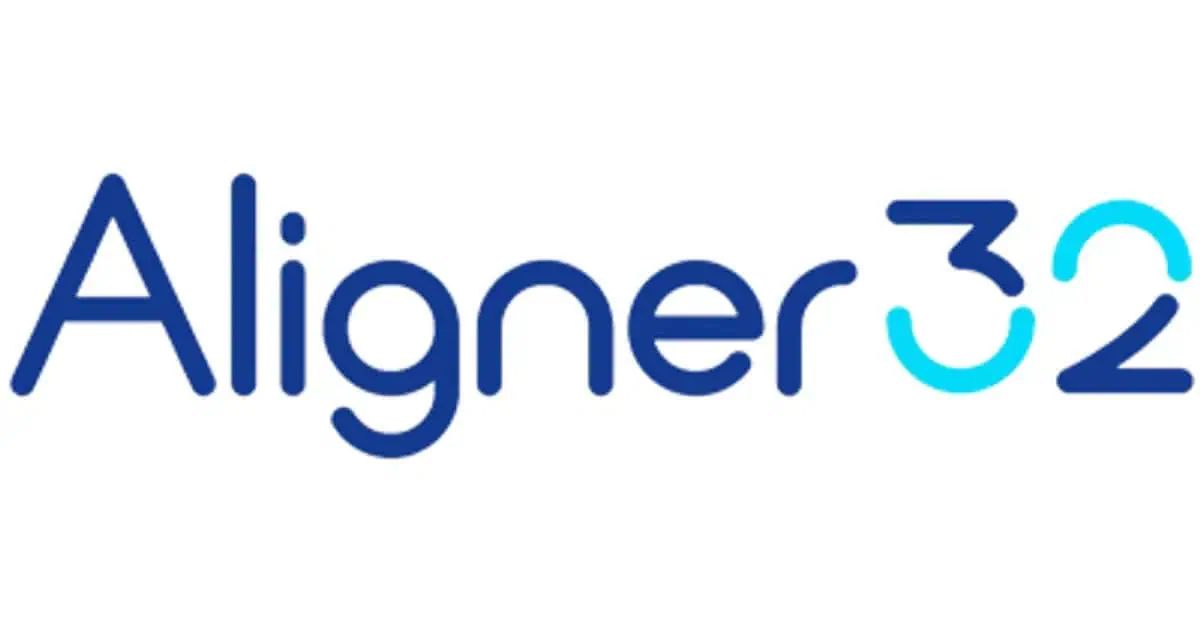If you have crooked or misaligned teeth, you may be considering getting braces. But, there are so many different types of braces out there, which ones are right for you?
Crooked teeth can have a really detrimental effect on your confidence, but then again, so can the idea of having a mouthful of metal train tracks. Don’t let that put you off though; there are different options, some more subtle than others.
We will discuss all kinds of braces so you can get a better idea of what may suit you and your dental needs, including:
- Traditional metal braces
- Lingual braces
- Ceramic braces
- Self-ligating braces
- Invisible braces
- Clear aligners
- Orthodontics appliances
Teeth straightening treatments and technology have come a long way since the original train track braces. There are all sorts of braces to choose from now, but the best ones for you may come down to your dental circumstances.
Let’s get started with the 2 main types of braces.
In This Article
What are the different types of teeth braces?
There are 2 main types of teeth braces for adults and kids: fixed and removable. Fixed braces can only be removed by a dental professional, whereas removable braces can be taken out by the patient at any point.
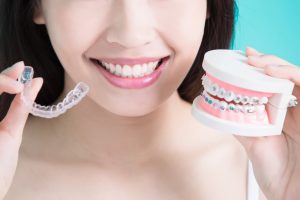
Fixed braces consist of brackets that are cemented to each tooth and are joined by wires that apply pressure to gradually align teeth. With traditional metal braces, elastic bands also help move teeth into the desired position.
Removable braces are invisible braces, also known as clear aligners, which are custom-made plastic trays that align your teeth. Generally, clear aligners involve a 3D scan or molds at the start of treatment so that trays can be made. A dentist or orthodontist monitors every step of the process so that they can make sure everything is moving in the right direction.
Fixed braces
The most well-known fixed brace is the traditional metal brace that consists of a system of stainless steel brackets and wires to straighten teeth. They are most commonly worn by children and teens, but with the advances in technology, braces are becoming more popular with adults.
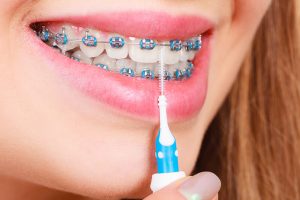
If you are wondering how to know if you need braces, read our article or book an appointment to speak with a dentist and get your teeth accessed.
Metal braces
Metal braces, also known as train tracks, traditional braces, or conventional braces are the oldest and most well-known type of braces. And, although there have been many advancements with braces, they are still the go-to treatment, especially if you want insurance to chip in.
They consist of metal brackets and wires that, along with rubber bands, help to treat even severe orthodontic problems. In more modern times dentists have started using heat-activated archwires that make adjustments easier.
You can also jazz them up a little bit with the use of colorful bands. Some of the pros and cons of metal braces include the following.
Pros
- Most affordable type of fixed braces
- Durable and not prone to damage
- Can treat even severe orthodontic problems
- Can use colorful bands to add a bit of fun
Adult orthodontic patients frequently prefer ceramic braces because they are less apparent than their
metal counterparts.
Ceramic braces are constructed from translucent materials, and some models even have wires
that match your teeth to enhance their covertness further. For some, this completely changes what it’s like to have braces as an adult.
Dr Azariy Yusupov, DDS, Amazing Smiles Orthodontics
Cons
- Very noticeable
- Cannot be removed
- Regular orthodontist or dentist trips to tighten wires
- Can cause gum irritation and discomfort
Ceramic braces
Ceramic braces or clear braces are very similar to traditional metal braces except they are clear or tooth-colored. The brackets are made from ceramic material instead of metal, and the wires are metal.
Pros
- Affordable
- Durable and not prone to damage
- Can treat even severe orthodontic problems
- More comfortable than metal braces
- Less noticeable
Cons
- Cannot be removed
- Regular orthodontist or dentist trips to tighten wires
- Ceramic is more brittle than metal
In the video below, Dr. Greg further explains the differences between clear and metal braces:
Lingual braces
Lingual braces are fixed braces that are attached behind the teeth, so they are not visible from the outside unless the mouth is open. They are also known as hidden braces or incognito braces. Lingual braces work very similarly to metal braces except for the fact they are positioned on the other side of the teeth.
Lingual braces are good for patients who are very self-conscious about their smile and appearance. And, although treatment takes longer, some people may prefer them to the more visible alternatives.
Pros
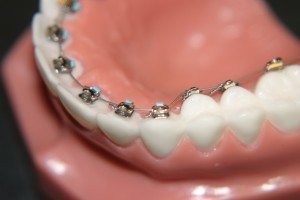
- Hidden, so good for those concerned with appearance
- Suitable for those who play musical instruments with their mouth
- Not prone to calcification like traditionally placed braces
Cons
- Take longer to treat
- Harder to adjust
- More expensive than traditional braces
- Regular orthodontist or dentist trips to tighten wires
- Can cause irritation to the tongue or speech problems
Self-ligating braces
Self-ligating braces have become more popular in recent years due to the fact they are less painful than the more traditional braces. They work and look very much the same as regular braces, except they do not use elastic bands to move teeth into alignment. Instead, they make use of a sliding bracket system with doors or clips that attach to the wire.
These braces are much easier to adjust and more comfortable; they also come in different ceramic and metal colors.
Pros
- Less painful
- Shorter treatment time than traditional braces
- Need fewer visits to the dentist for adjustments
Cons
- Not suitable for everyone
- More expensive than traditional braces
- More noticeable than other types of braces
- Need careful attention and special equipment when cleaning and brushing with braces
Removable braces
Removable braces have become very popular with adults due to the fact that they are practically unnoticeable when worn. They are easily removed which makes eating more comfortable, and they can be worn when you are asleep and removed more in the day for meals and snacks.
They use pressure to gradually align and move teeth into the desired position over time.
Clear aligners
Also known as invisible braces, these are custom-made plastic trays that help to align teeth over time. Some, especially the remote treatment type, cannot treat as severe cases as fixed braces, but they can treat mild to moderate cases for those just to straighten teeth a bit.
In-office invisible braces can treat a wider range of cases. The most popular type of invisible brace is Invisalign, which can treat up to 90% of orthodontic cases and is very effective.
That being said, the brands that offer remote treatment are advancing constantly and becoming more efficient at straightening teeth from home.
We always recommend consulting your dentist before choosing a type of clear aligner or any type of dental treatment. You can read more about clear aligners and Invisalign alternatives if you’d like to know more.
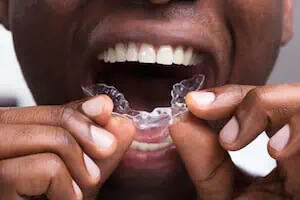
Pros
- Comfortable to wear
- Almost invisible
- Removable
- Easy to clean and maintain
- Faster treatment time
- Less noticeable than other styles of brace
Cons
- Not suitable for severe dental problems
- More expensive than traditional braces
Have a look at the table below that compares some of our top picks for remote treatment with clear aligners if you are looking for treatment for a mild case of malocclusion.
- Most affordable options
- Single and dual arch, day and night options
- Convenient AlignerTracker app
- Free teeth whitening
Aligner32 offers a convenient and affordable way for individuals to straighten their teeth using custom-fit clear aligners. Their service is designed for at-home use, allowing customers to avoid frequent orthodontist visits while still achieving professional-grade results.
Aligner32 provides two main treatment plans tailored to suit different needs:
- All-Day Plan: The All-Day Plan requires 22 hours of daily wear and offers faster results, with treatment lasting between 4 to 6 months.
- Night Wear Plan: The Night Wear Plan is ideal for those who prefer a more flexible routine, requiring just 10 hours of daily wear, typically at night, with a treatment duration of 6 to 8 months.
Both plans are designed to treat a range of orthodontic issues, including crowding, spacing, overbites, underbites, and crossbites.
With affordability in mind, Aligner32’s clear aligners are significantly less expensive than traditional braces, which can cost between $5,000 to $8,000. Customers can also use flexible payment plans, making it easier to manage the cost.
Additionally, Aligner32 offers a free teeth whitening kit with their aligner packages, making the treatment even more appealing. The company emphasizes comfort, convenience, and professional care, making it a popular choice for those seeking a better smile without the high costs and hassle of conventional orthodontic treatments.
- Complete treatment 100% remotely
- Amazing customer service
- Nighttime-only option
- $1,495 or $55/month
NewSmile aligners are made from the clearest Essix plastic and come with a daytime or nighttime-only option to suit you. For just $1,495 you’ll receive everything you need to straighten and whiten your teeth – and maintain your new smile:
- Home impression kit
- Full aligner treatment
- Free whitening
- First set of retainers
- A full refund if you’re not a good fit
NewSmile goes above and beyond to provide a great experience to all their customers, beginning with a live video call to help you with your teeth impressions. Mail these back, and they’ll send a 3D Treatment Preview for you to approve before going ahead.
- Smileie Pro offers hybrid treatment!
- Single-arch treatment option
- Nighttime aligners available
- Free refinements & 2 sets of retainers
- $699 (single-arch) or $999 (dual-arch)
Smileie’s aligner treatment is not only affordable, but flexible too. You have the option of Smileie Pro, which is hybrid treatment that involves in-office visits with a dentist.
That means more accurate, safer and effective treatment or a wider variety of cases.
But you can also opt for single-arch treatment for just your top or bottom teeth, as well as nighttime-only treatment. And whichever package you choose, monthly payments are available.
On top of this, Smileie offers a 100% satisfaction guarantee which includes free refinements if needed. Their aligners are made in the US and treatment takes 4-6 months on average.
Get Smileie Pro for just $1499, or —
Get the best discount on the standard plan, with 100% remote treatment, when you purchase your aligner package up-front, including:
- Home impression kit
- Teeth whitening kit
- Two sets of retainers
- A full refund if you’re not a good candidate
Packages start at $699 for single-arch treatment. Click below to check for current discounts!
- Complete treatment 100% remotely
- 4-6 month average treatment time
- Nighttime-only option
- $770 or $64/month
If you’re looking for the best value aligner package, here it is! For just $895 you’ll get:
- Impression kit
- Full aligner treatment course
- Free teeth whitening kit
- Your first set of retainers
In short, everything needed to straighten your teeth remotely and keep them looking great, with a full money-back guarantee if you’re not a suitable candidate.
This low price doesn’t mean you’re compromising on quality of care, though. ALIGNERCO just choose not to put so much into marketing, and they pass on the savings to their customers. They are also known for their responsive and helpful customer care, which is important when you’re doing things from home.
Nighttime-only aligners are also available for anyone who doesn’t want to wear aligners during the day.
Functional Braces
While functional braces are not necessarily braces, they can be used prior to treatment to help with misalignment and malocclusion. They are orthodontic appliances that are two removable parts that work together to align your bite and change your facial profile.
Twin block braces are a type of orthodontic appliance that restricts you from closing your jaws completely unless they are in the desired position. Over time this will persuade your jaw and bite into the correct position.
Pros
- Aligns your bite
- Changes facial profile
- Easy to clean
- Removable
Cons
- Can add up to 12 months to your treatment
- Can be uncomfortable to wear
- More suitable for children with growing jaws
Conclusion
If you want to straighten your teeth and improve your smile, but are not sure about wearing braces, don’t let that put you off. There are many kinds of braces to choose from, and even if your orthodontic case is severe you may have options.
Fixed braces are more commonly used for more severe problems. However, if you are concerned about your appearance ask your dentist or orthodontist which types of braces you are eligible for. You can read about the different kinds in our full guide here.
If you need fixed braces but are concerned about how they look, ceramic braces or lingual braces might be a good option for you. Invisible braces are also a good option if you don’t want your braces to be noticeable, however it may depend if they are suitable for your orthodontic needs.
If you still have concerns, speak with your dentist to help you make a decision on which braces are best for you.
FAQS
What are ceramic braces?
Ceramic braces are similar to traditional fixed braces, except the brackets are made from clear or tooth-colored ceramic material. These braces are more subtle and comfortable than metal braces.
What is the difference between fixed braces and removable braces?
Fixed braces are braces that consist of brackets and wire that are cemented into place and can only be removed by a dental professional. These are commonly used for more moderate to severe cases.





